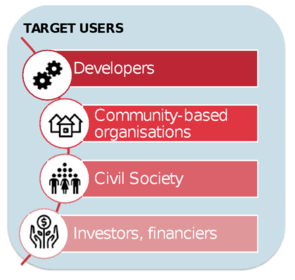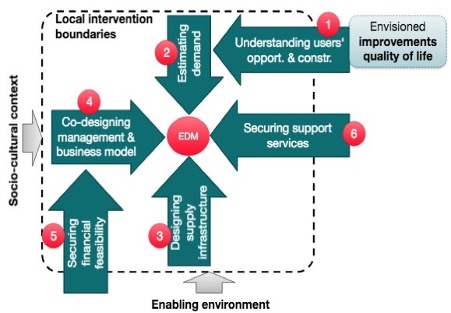Difference between revisions of "Guide to the Nigeria Off-Grid Solar Knowledge Hub"
***** (***** | *****) m |
***** (***** | *****) |
||
| Line 3: | Line 3: | ||
==Introduction== | ==Introduction== | ||
| − | '''The Nigeria Off-Grid Solar Knowledge Hub was created within the PeopleSuN project, in collaboration with Nigerian stakeholders. This open access hub aims to contribute to bridging the skills gap in the Nigerian off-grid solar sector by facilitating knowledge exchange and collaboration. Users | + | '''The Nigeria Off-Grid Solar Knowledge Hub was created within the PeopleSuN project, in collaboration with Nigerian stakeholders. This open access hub aims to contribute to bridging the skills gap in the Nigerian off-grid solar sector by facilitating knowledge exchange and collaboration. Users are kindly encouraged to actively contribute to this hub by creating new inputs and sharing their own experiences.''' Ultimately, the hub seeks to support the design and implementation of financially viable and inclusive off-grid power interventions in underserved areas across Nigeria. |
| + | |||
| + | Figure 1 shows the main target users for this hub. However, every interested person is invited to use and contribute to the Hub. | ||
| + | |||
| + | [[File:Bildschirmfoto 2023-07-25 um 14.28.56.png|295x295px]] | ||
| + | |||
| + | ''Figure 1: Target users of the Nigeria Off-Grid Solar Knowledge Hub'' | ||
==Structure of the Hub== | ==Structure of the Hub== | ||
| − | The dimensions in this hub are based on the Energy Delivery Model (EDM) framework<ref>Bellanca, R., & Garside, B. (2013). An approach to designing energy delivery models that work for people living in poverty. <nowiki>https://pubs.iied.org/16551iied</nowiki></ref>. This framework illustrates different key dimensions that are all part of developing a sustainable renewable | + | The dimensions in this hub are based on the Energy Delivery Model (EDM) framework<ref>Bellanca, R., & Garside, B. (2013). An approach to designing energy delivery models that work for people living in poverty. <nowiki>https://pubs.iied.org/16551iied</nowiki></ref>. This framework illustrates the different key dimensions that are all part of developing a sustainable renewable electrification intervention (Figure 1). |
| + | |||
| + | [[File:Key_steps_in_process_of_designing_Energy_Delivery_Model.jpg|alt=|451x451px]] | ||
| + | |||
| + | ''Figure 2: Key steps in process of designing an Energy Delivery Model'' | ||
| + | |||
| + | Each dimension in this hub follows a similar structure. After giving a brief introduction, relevant definitions are provided to help understanding the respective topic. In some sections, challenges are listed. Afterwards, some guiding principles for each dimension are elaborated to provide context of the topic. Lastly, a list of existing tools and resources is attached within each dimension. Every section can be edited and u'''sers are kindly encouraged to especially add on to the lists of tools and resources.''' | ||
| + | |||
| + | The Highlights section that is found at the bottom of the [[Nigeria Off-Grid Solar Knowledge Hub|main page]] includes the different tools and resources that were developed within the PeopleSuN project. They all relate to certain dimensions of the EDM framework and thus can also be found in the respective dimension. The [[Nigeria Off-Grid Solar Knowledge Hub - Case Studies Overview|case studies overview]] shows the series of case studies developed within PeopleSuN. Each case study focuses on an existing electrification intervention to inform about good practices and lessons learned, spanning different solutions (minigrids, solar home systems, etc.). | ||
| + | |||
| + | == How to contribute to the Hub == | ||
| + | To be able to work on Energypedia, one needs to register first. In case you have no account yet, use this [[Special:RequestAccount|link]] to register. You don't need to be an energy expert in order to request an account. After submission, it might take some hours until the account is activated. | ||
| + | |||
| + | Please consult [[Nigeria Off-Grid Solar Knowledge Hub - How to Contribute|this article]] on how to make edits in the Knowledge Hub. | ||
==Bibliography== | ==Bibliography== | ||
Revision as of 13:06, 25 July 2023
Introduction
The Nigeria Off-Grid Solar Knowledge Hub was created within the PeopleSuN project, in collaboration with Nigerian stakeholders. This open access hub aims to contribute to bridging the skills gap in the Nigerian off-grid solar sector by facilitating knowledge exchange and collaboration. Users are kindly encouraged to actively contribute to this hub by creating new inputs and sharing their own experiences. Ultimately, the hub seeks to support the design and implementation of financially viable and inclusive off-grid power interventions in underserved areas across Nigeria.
Figure 1 shows the main target users for this hub. However, every interested person is invited to use and contribute to the Hub.
Figure 1: Target users of the Nigeria Off-Grid Solar Knowledge Hub
Structure of the Hub
The dimensions in this hub are based on the Energy Delivery Model (EDM) framework[1]. This framework illustrates the different key dimensions that are all part of developing a sustainable renewable electrification intervention (Figure 1).
Figure 2: Key steps in process of designing an Energy Delivery Model
Each dimension in this hub follows a similar structure. After giving a brief introduction, relevant definitions are provided to help understanding the respective topic. In some sections, challenges are listed. Afterwards, some guiding principles for each dimension are elaborated to provide context of the topic. Lastly, a list of existing tools and resources is attached within each dimension. Every section can be edited and users are kindly encouraged to especially add on to the lists of tools and resources.
The Highlights section that is found at the bottom of the main page includes the different tools and resources that were developed within the PeopleSuN project. They all relate to certain dimensions of the EDM framework and thus can also be found in the respective dimension. The case studies overview shows the series of case studies developed within PeopleSuN. Each case study focuses on an existing electrification intervention to inform about good practices and lessons learned, spanning different solutions (minigrids, solar home systems, etc.).
How to contribute to the Hub
To be able to work on Energypedia, one needs to register first. In case you have no account yet, use this link to register. You don't need to be an energy expert in order to request an account. After submission, it might take some hours until the account is activated.
Please consult this article on how to make edits in the Knowledge Hub.
Bibliography
- ↑ Bellanca, R., & Garside, B. (2013). An approach to designing energy delivery models that work for people living in poverty. https://pubs.iied.org/16551iied





















